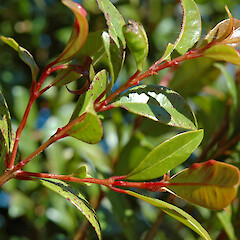Syzygium australe
Common name
brush cherry
Synonyms
Eugenia australis Wendl. ex Link
Family
Myrtaceae
Flora category
Vascular – Exotic
Structural class
Trees & Shrubs - Dicotyledons
Conservation status
Not applicable
Brief description
Large shrub or small tree to 10m; smooth, light grey bark; white petals; fruit 2x2.5cm, oblong to ovoid, crimson to purple (Webb et al., 1988).
Habitat
Terrestrial.
Detailed description
Large shrub or small tree to approx. 10m high; bark smooth, light grey; pneumatophores 0. Branchlets pendent, angular. Leaves aromatic when crushed; petiole < 10mm long. Lamina mostly 4~10 x 1~3.5cm, sometimes smaller near base of branchlets and below infl., often narrowly elliptic, sometimes elliptic or obovate, glossy, slightly undulate; veins numerous, conspicuous and parallel; base attenuate or narrowly cuneate; apex mostly cuspidate to acuminate, but sharply acute in obovate leaves. Cymes with 3~25 flowers, terminal or in the upper axils of short leafy branchlets, to about 15cm diam.; peduncles to approx. 4cm long; pedicels shorter, slender, angular. Hypanthium 4~6mm long at antithesis, obconic, generally dark red at least on exposed side; pseudopedicel hardly evident; calyx lobes 2~4mm long, broadly triangular-ovate, sometimes dark red, persistent on fruit. Petals around 4mm diam., free, suborbicular, white, caducous. Stamens to approx. 13mm long, white. Style generally = longest stamens. Fruit 1~2 x .7~1.5cm, oblong to obovoid, crimson to crimson-purple, usu. glossy. Seed 1 or few, large; cotyledons green. (Webb et al., 1988)
Manaaki Whenua Online Interactive Key
Similar taxa
Syzygium paniculatum. In NZ, S. paniculatum is sometimes sold erroneously as S. australe. The two can be distinguished even when young from the leafy twigs, which in S. paniculatum have smooth internodes above and below the nodes, whereas S. australe has its leafy twigs “generally 4-angled or shortly 4-winged, pairs of wings running down from each petiole but amalgamating and forming a pocket or hump above the next lower pair of leaves.” These can be seen in the photo on this page taken in Wellington Zoological Gardens. http://keys.trin.org.au/key-server/data/0e0f0504-0103-430d-8004-060d07080d04/media/Html/taxon/Syzygium_australe.htm
S. australe appears to be a lot less common in cultivation than S. paniculatum and, compared with the latter, wild seedlings are uncommon in S. australe.
Flowering
January, February, March, April, May, June, July
Flower colours
White
Life cycle
Perennial. The fleshy fruit are distributed by birds (Webb et al., 1988).
Threats
This taxon may be prone to Myrtle Rust (Austropuccinia psidii) is an invasive fungus which threatens myrtle species - learn more myrtlerust.org.nz
Year naturalised
1983
Origin
Qld, NSW
Reason for introduction
Ornamental
Etymology
syzygium: From the Greek syzygos ‘joined’, referring to the paired leaves
australe: Southern, from the Latin australis


